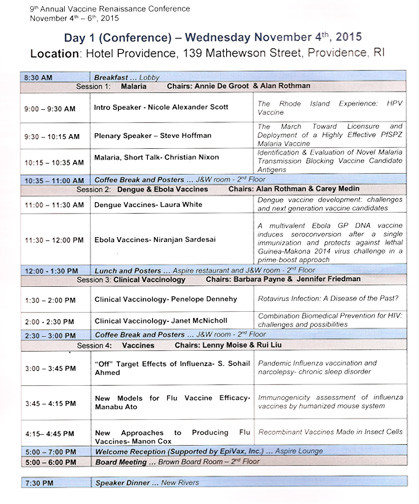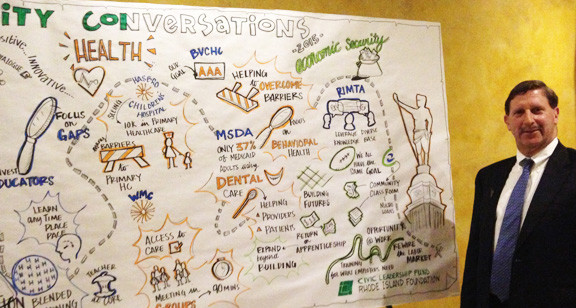Two stories that did not fit into a TV narrative during sweeps
Collaborative, contemplative, innovative, successful, even earth-shaking news but not sensational enough?
PROVIDENCE – By all indicators, the presentation at the 9th annual Vaccine Renaissance convention on Nov. 4 about the encouraging efforts to develop an effective, injectable vaccine against malaria should have been front-page news and leading the local TV news broadcasts.
About 3.2 billion people – half of the world’s population – are at risk of contracting malaria, according to the World Health Organization. In 2015, there will be roughly 214 million malaria cases and an estimated 438,000 deaths, despite more than $3 billion invested annually in malaria control.
Sub-Saharan Africa continues to carry a disproportionate high share of the burden, with the region home to about 89 percent of the malaria cases and 91 percent of the deaths caused by malaria.
Ask any of the political scientists or scholars, say, at Brown University’s Watson Institute: Do you think that the tumult and disarray and political turmoil in the Sub-Saharan countries is a breeding ground not just for malaria but for terrorism and radical Islamists. Do you think there might be a connection?
Dr. Stanley Hoffman, the CEO of Sanaria, Inc., a company devoted to developing a highly effective vaccine to the bites from the PfSPZ [Plasmodium faciparum sporozite]-infected mosquito, gave the plenary talk on the first day of the conference.
While the science may have been a bit out-of-reach for the casual observing news reporter, the results were not: some 2,000 doses of the new vaccine have been administered in clinical trials in the U.S., in Europe and in Africa, with 100 percent protection achieved with three doses of the vaccine in a second trial, and protection sustained for at least six months demonstrated in Africa.
More importantly, perhaps, was the willingness of Hoffman to share his data, openly, in a collaborative fashion, and to praise all of his numerous collaborative partners.
The injections of the vaccine, done intravenously, produced no real documented experiences of pain by the recipients, despite detailed tracking, another surprising finding. Further, Hoffman and his team had developed a way to keep the vaccine cool using liquid nitrogen in portable packs, overcoming the heat and weather barriers in reaching remote areas.
In his talk, Hoffman described the next steps are to move toward licensure and deployment, an effort that could change the economic face of many developing countries.
Ebola, dengue and H7N9
Few in the general public need to be reminded of the world-wide scare related to the transmission of the Ebola vaccine and what happened here in the U.S., after a patient presented himself at a Dallas hospital and was inexplicably sent home.
Remember how a nurse, who had treated Ebola patients, returned from Africa, only to have been forced into an ad hoc quarantine by N.J. Gov. Chris Christie, despite being symptom free. [Christie has now been sued by the nurse, in a civil proceeding.] Then she hounded for days by the news media in front of her home in Maine, traipsing after her in a memorable video when she took a bike ride. Remember?
Everywhere, including here in Rhode Island, emergency plans were put into place to handle the potential of an Ebola case, under the scrutiny of a heavy-breathing news media.
A year later, however, the news media did not appear to be interested in learning about the progress that had been made in creating vaccines for both Ebola and Dengue, both of which were discussed at length at the Vaccine Renaissance conference.
Or, how Dr. Manabu Ato, director of the National Institute of Infectious Diseases in Japan, had developed a humanized mouse system that mimics immunological memory responses to influenza vaccination, in particular the H7N9 virus. It’s an important achievement, given the low immunogenicity of H7N9 vaccine candidates in humans, based on recent immuno-informatic analysis done by Dr. Annie De Groot and her team at EpiVax, and its potential to become the next pandemic flu among H7 subtypes.
In addition, Dr. S. Sohail Ahmed, the global head of Clinical Sciences at Novartis Vaccines and Diagnostics in Siena, Italy, [now a GSK company], spoke about the relationship between pandemic influenza vaccination and narcolepsy.
And, Manon Cox, CEO of Protein Sciences, spoke about the planned growth in production of the first FDA-approved recombinant flu vaccine, Flublok, available in Rhode Island at all Target stores. [See link below to ConvergenceRI story. ]
Was it news for a Rhode Island audience? Did it not make for good TV? Instead, how many stories were there about Presidential candidate Ben Carson’s non-scientific opinion that the pyramids were built to store grain, not as large-scale burial tombs?
The Vaccine Renaissance conference highlighted the expertise and prowess of that is located here in Rhode Island, sponsored by iCubed, the Institute for Immunology and Informatics at the University of Rhode Island. Was anyone from the Brookings Institute there to listen and observe?
The conference was sponsored by: Protein Sciences, 21st Century Biochemicals, EpiVax, Inovio Pharmaceuticals, the National Institutes of Health, MABTECH, and the Immune-based Interventions against Infectious Diseases COBRE, a partnership with the University of Rhode Island and Lifespan.
A community conversation
Another fascinating event, the 2015 Community Conversation hosted by The Rhode Island Foundation, featuring 12 groups that had been awarded grants to work to promote educational success, healthy lives and economic security, was held on Nov. 5 at the Park Theatre in Cranston.
There were no TV cameras or microphones of radio reporters covering the event, which, once again, probably didn’t make for good TV during sweeps.
Interestingly, the very topics covered – educational success, healthy lives and economic security – are on tap to be discussed again as part of the Publick Occurrences forum, sponsored by The Providence Journal and Leadership Rhode Island, in partnership with Rhode Island College.
One would think that a reporter, or a newspaper editor, or even an assignment editor at a TV station, might want to learn about the successful initiatives and interventions already under way in Rhode Island.
The presentations were done in succinct, pithy, four-minute stories: for educational success, they featured the efforts of the Providence After School Alliance, the Highlander Institute, the Center for Leadership and Educational Equity, and the Rhode Island Department of Education.
When Andrea Castaneda of the R.I. Department of Education spoke, she broke away from her prepared remarks to talk about how government can inspire, but it can also embarrass, referring to R.I. House Speaker Nicholas Mattiello’s remarks about not having experienced “white privilege,” saying, that as a Latina: “White privilege has a seat at every table.” Her remarks received a resounding burst of applause.
Her message was about how a strategic plan for education had not been written as a top-down exercise, but as collaborative effort, with parents, teachers, students and administrators participating – and writing the actual report.
On the health care front, Dr. Patrick Vivier talked about the importance of the support to help transform the pediatric clinic into a team-based approach at Hasbro Children’s Hospital. A sllde graphically showed the challenge facing the clinic.
Christine Hansen, the COO at Blackstone Valley Community Health Care, talked about how the development of community health worker teams and their ability to bring care to where the patient lived had enabled a difficult patient situation to be overcome, by working with a nurse care manager, integrating behavioral health into primary care.
Dr. Peg Miller from the Women’s Medicine Collaborative talked about a new approach to managing resources, a shared session with a team of caregivers, involving multiple patients in the same room, which had achieve enormous success rates in outcomes and patient satisfaction. The biggest stumbling block was one of medical coding, Miller explained; there was no ICD 10 code for such services, and it required being able to work around that to get reimbursed.
On the economic security front, the major messages were about networking, creating apprenticeships, defining capability by expertise, not by credentials, and supporting a different model for enterprise.
Here were 12 stories about successful interventions and initiatives about what was being done already in Rhode Island, but if they happened within the forest that is the Rhode Island news media during sweeps, did anyone hear them?







